KIA CERATO 2006 Repair Manual
Manufacturer: KIA, Model Year: 2006, Model line: CERATO, Model: KIA CERATO 2006Pages: 315, PDF Size: 11.29 MB
Page 61 of 315
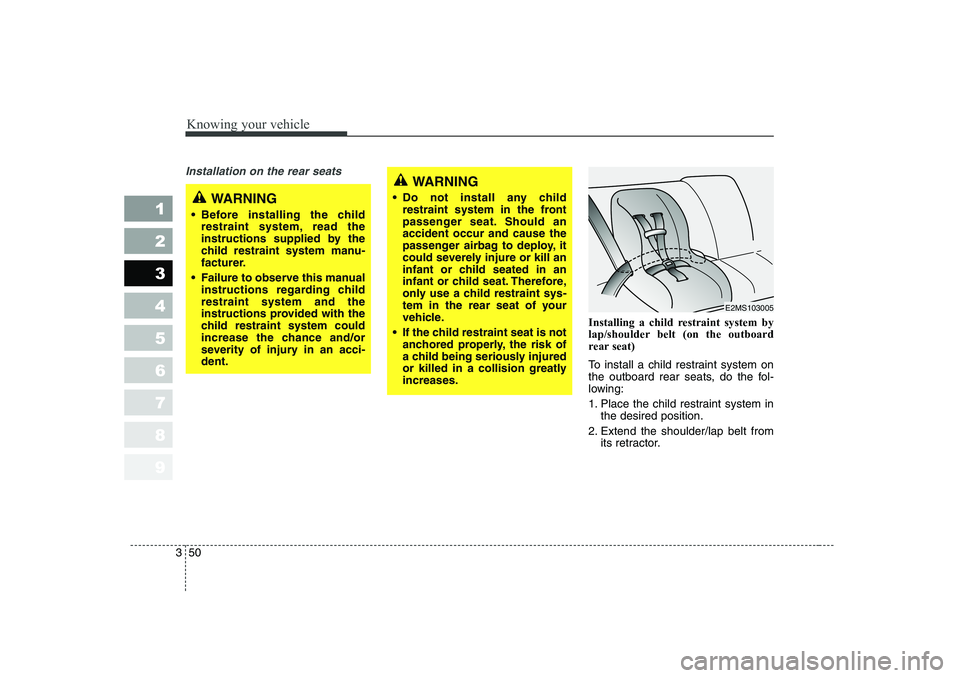
Knowing your vehicle
50
3
1 23456789
Installation on the rear seats
Installing a child restraint system by
lap/shoulder belt (on the outboard
rear seat)
To install a child restraint system on
the outboard rear seats, do the fol-
lowing:
1. Place the child restraint system in
the desired position.
2. Extend the shoulder/lap belt from its retractor.
WARNING
Do not install any child restraint system in the front
passenger seat. Should anaccident occur and cause the
passenger airbag to deploy, it
could severely injure or kill an
infant or child seated in an
infant or child seat. Therefore,
only use a child restraint sys-
tem in the rear seat of your
vehicle.
If the child restraint seat is not anchored properly, the risk of
a child being seriously injured
or killed in a collision greatlyincreases.
WARNING
Before installing the child restraint system, read the
instructions supplied by the
child restraint system manu-
facturer.
Failure to observe this manual instructions regarding childrestraint system and the
instructions provided with the
child restraint system could
increase the chance and/or
severity of injury in an acci-dent.
E2MS103005
Page 62 of 315
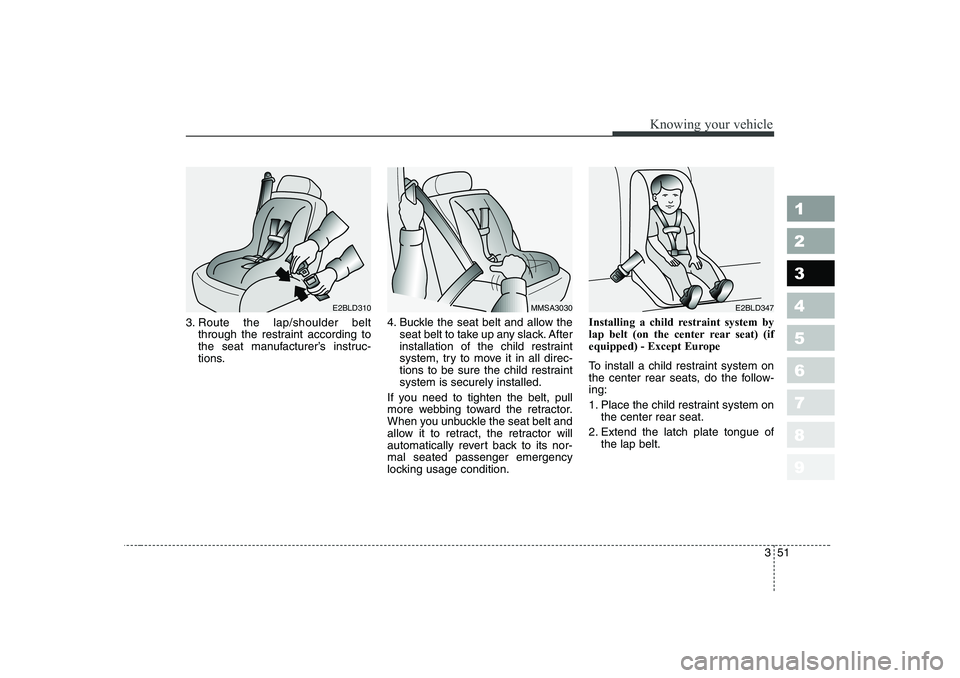
351
1 23456789
Knowing your vehicle
3. Route the lap/shoulder beltthrough the restraint according to
the seat manufacturer’s instruc-
tions. 4. Buckle the seat belt and allow the
seat belt to take up any slack. After
installation of the child restraint
system, try to move it in all direc-
tions to be sure the child restraintsystem is securely installed.
If you need to tighten the belt, pull
more webbing toward the retractor.
When you unbuckle the seat belt and
allow it to retract, the retractor will
automatically revert back to its nor-mal seated passenger emergency
locking usage condition. Installing a child restraint system by
lap belt (on the center rear seat) (if
equipped) - Except Europe
To install a child restraint system on
the center rear seats, do the follow-ing:
1. Place the child restraint system on
the center rear seat.
2. Extend the latch plate tongue of the lap belt.
MMSA3030E2BLD310E2BLD347
Page 63 of 315
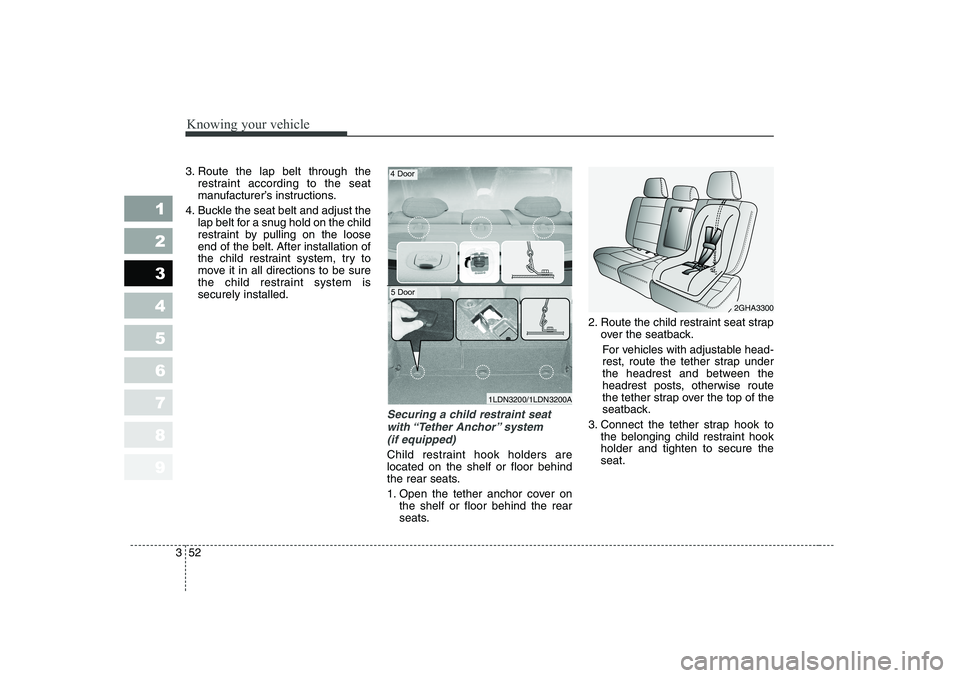
Knowing your vehicle
52
3
1 23456789
3. Route the lap belt through the
restraint according to the seat
manufacturer’s instructions.
4. Buckle the seat belt and adjust the lap belt for a snug hold on the child
restraint by pulling on the loose
end of the belt. After installation of
the child restraint system, try to
move it in all directions to be sure
the child restraint system issecurely installed.
Securing a child restraint seat
with “Tether Anchor” system (if equipped)
Child restraint hook holders are located on the shelf or floor behind
the rear seats.
1. Open the tether anchor cover on the shelf or floor behind the rear
seats. 2. Route the child restraint seat strap
over the seatback.
For vehicles with adjustable head-
rest, route the tether strap under
the headrest and between the
headrest posts, otherwise route
the tether strap over the top of the
seatback.
3. Connect the tether strap hook to the belonging child restraint hookholder and tighten to secure theseat.
1LDN3200/1LDN3200A
2GHA3300
4 Door
5 Door
Page 64 of 315
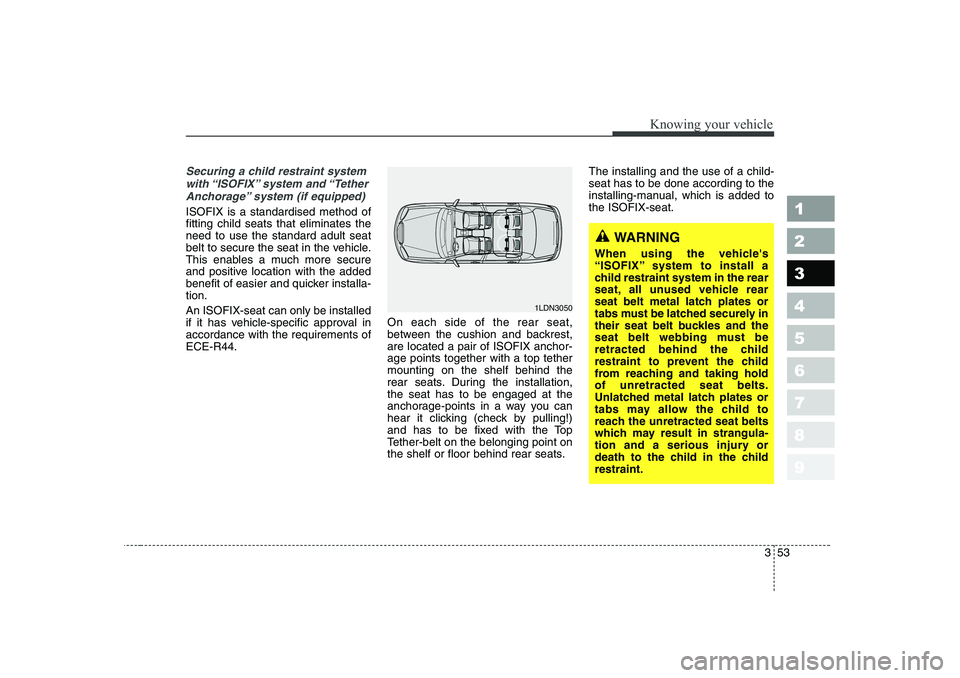
353
1 23456789
Knowing your vehicle
Securing a child restraint systemwith “ISOFIX” system and “TetherAnchorage” system (if equipped)
ISOFIX is a standardised method of fitting child seats that eliminates theneed to use the standard adult seat
belt to secure the seat in the vehicle.
This enables a much more secure
and positive location with the added
benefit of easier and quicker installa-tion. An ISOFIX-seat can only be installed
if it has vehicle-specific approval inaccordance with the requirements ofECE-R44. On each side of the rear seat,
between the cushion and backrest,are located a pair of ISOFIX anchor-age points together with a top tethermounting on the shelf behind the
rear seats. During the installation,the seat has to be engaged at the
anchorage-points in a way you can
hear it clicking (check by pulling!)
and has to be fixed with the Top
Tether-belt on the belonging point on
the shelf or floor behind rear seats.The installing and the use of a child-seat has to be done according to the
installing-manual, which is added tothe ISOFIX-seat.
1LDN3050
WARNING
When using the vehicle's
“ISOFIX” system to install a
child restraint system in the rear
seat, all unused vehicle rear
seat belt metal latch plates or
tabs must be latched securely in
their seat belt buckles and the
seat belt webbing must be
retracted behind the child
restraint to prevent the child
from reaching and taking holdof unretracted seat belts.
Unlatched metal latch plates or
tabs may allow the child to
reach the unretracted seat belts
which may result in strangula-
tion and a serious injury or
death to the child in the childrestraint.
Page 65 of 315
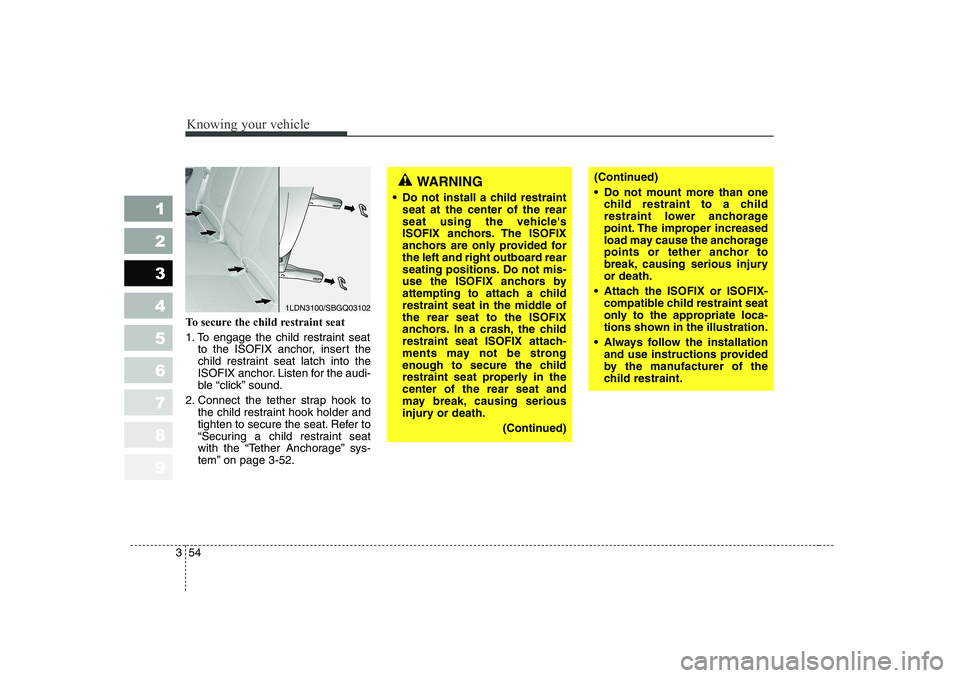
Knowing your vehicle
54
3
1 23456789
(Continued)
Do not mount more than one
child restraint to a child
restraint lower anchorage
point. The improper increased
load may cause the anchorage
points or tether anchor to
break, causing serious injuryor death.
Attach the ISOFIX or ISOFIX- compatible child restraint seat
only to the appropriate loca-
tions shown in the illustration.
Always follow the installation and use instructions provided
by the manufacturer of the
child restraint.
To secure the child restraint seat
1. To engage the child restraint seat
to the ISOFIX anchor, insert the
child restraint seat latch into the
ISOFIX anchor. Listen for the audi-
ble “click” sound.
2. Connect the tether strap hook to the child restraint hook holder and
tighten to secure the seat. Refer to
“Securing a child restraint seat
with the “Tether Anchorage” sys-
tem” on page 3-52.
1LDN3100/SBGQ03102
WARNING
Do not install a child restraint seat at the center of the rear
seat using the vehicle's
ISOFIX anchors. The ISOFIX
anchors are only provided for
the left and right outboard rear
seating positions. Do not mis-
use the ISOFIX anchors by
attempting to attach a child
restraint seat in the middle ofthe rear seat to the ISOFIX
anchors. In a crash, the child
restraint seat ISOFIX attach-
ments may not be strong
enough to secure the child
restraint seat properly in thecenter of the rear seat and
may break, causing serious
injury or death.
(Continued)
Page 66 of 315
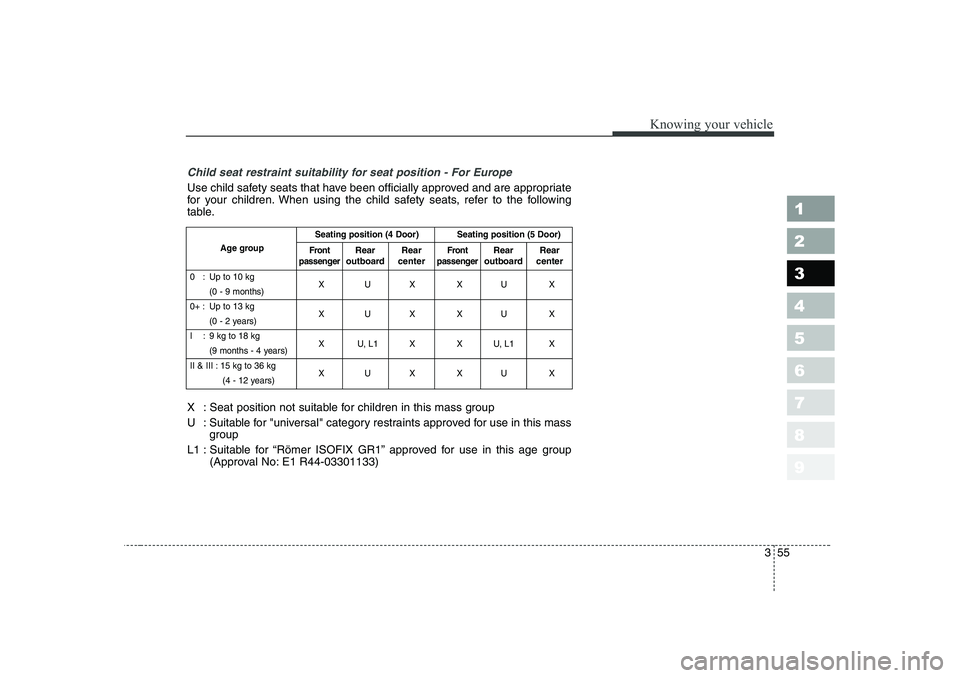
355
1 23456789
Knowing your vehicle
Child seat restraint suitability for seat position - For Europe
Use child safety seats that have been officially approved and are appropriate
for your children. When using the child safety seats, refer to the following
table.
X : Seat position not suitable for children in this mass group
U : Suitable for "universal" category restraints approved for use in this massgroup
L1 : Suitable for “Römer ISOFIX GR1” approved for use in this age group (Approval No: E1 R44-03301133)
Seating position (4 Door) Seating position (5 Door)
Age group
0 : Up to 10 kg XUX XU X
(0 - 9 months)
0+ : Up to 13 kg XUX XU X
(0 - 2 years)
I : 9 kg to 18 kg X U, L1 X X U, L1 X
(9 months - 4 years)
II & III : 15 kg to 36 kg XUX XU X
(4 - 12 years)
Front
passengerRear
outboard Rear
centerFront
passengerRear
outboard Rear
center
Page 67 of 315
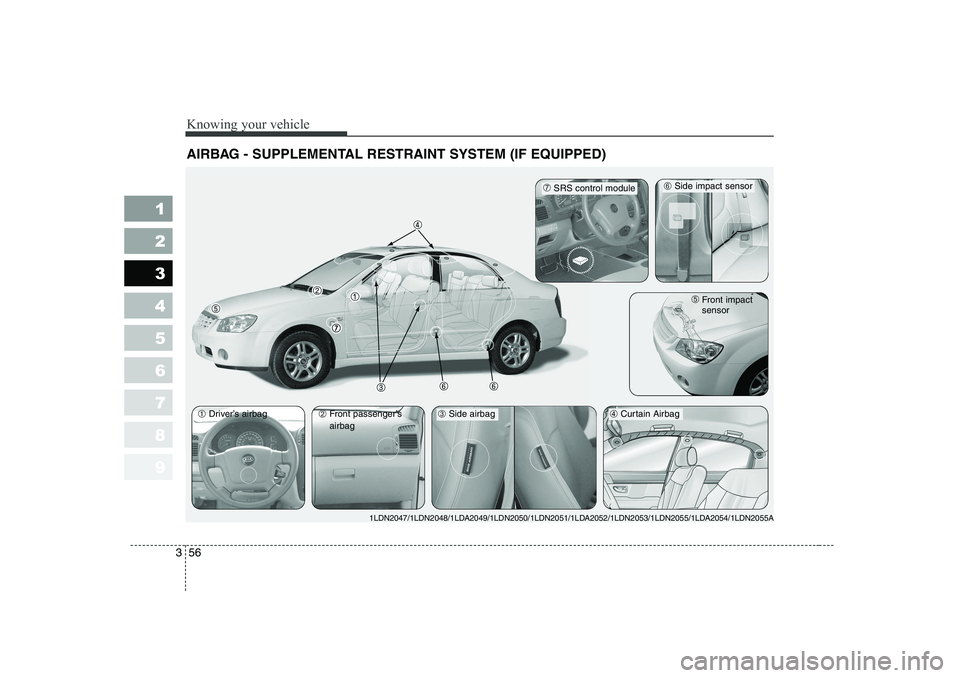
Knowing your vehicle
56
3
1 23456789
AIRBAG - SUPPLEMENTAL RESTRAINT SYSTEM (IF EQUIPPED)
➀ Driver’s airbag
➁Front passenger’s airbag➃ Curtain Airbag ➄
Front impact sensor
➆SRS control module
1LDN2047/1LDN2048/1LDA2049/1LDN2050/1LDN2051/1LDA2052/1LDN2053/1LDN2055/1LDA2054/1LDN2055A
➂ Side airbag
➅Side impact sensor
Page 68 of 315
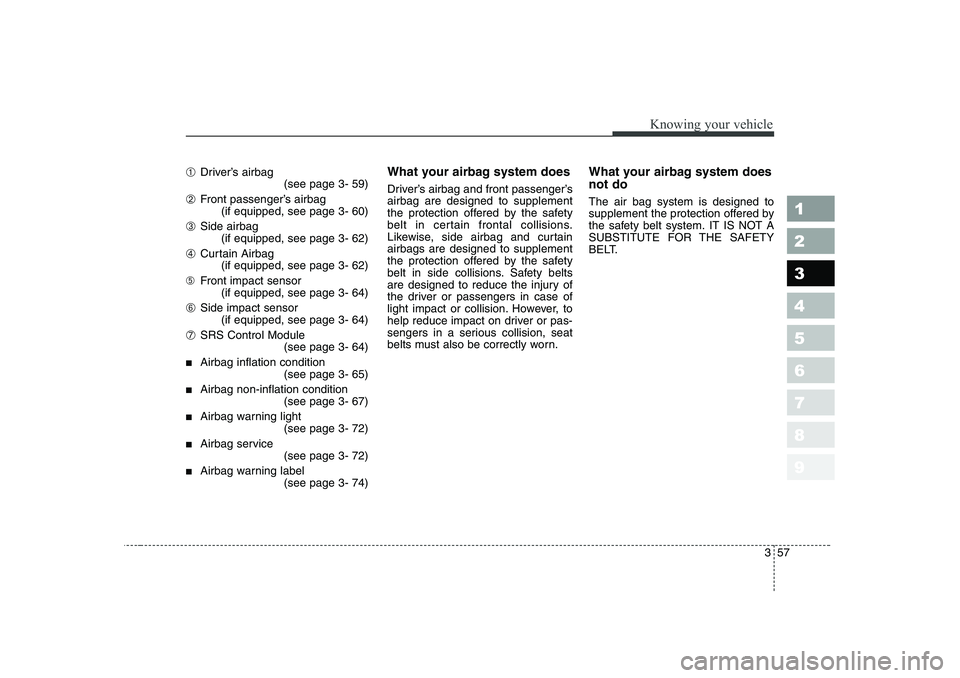
357
1 23456789
Knowing your vehicle
➀Driver’s airbag
(see page 3- 59)
➁ Front passenger’s airbag
(if equipped, see page 3- 60)
➂ Side airbag
(if equipped, see page 3- 62)
➃ Curtain Airbag
(if equipped, see page 3- 62)
➄ Front impact sensor
(if equipped, see page 3- 64)
➅ Side impact sensor
(if equipped, see page 3- 64)
➆ SRS Control Module
(see page 3- 64)
■ Airbag inflation condition
(see page 3- 65)
■ Airbag non-inflation condition
(see page 3- 67)
■ Airbag warning light
(see page 3- 72)
■ Airbag service
(see page 3- 72)
■ Airbag warning label
(see page 3- 74) What your airbag system does
Driver’s airbag and front passenger’s airbag are designed to supplement
the protection offered by the safety
belt in certain frontal collisions.
Likewise, side airbag and curtainairbags are designed to supplement
the protection offered by the safety
belt in side collisions. Safety belts
are designed to reduce the injury of
the driver or passengers in case of
light impact or collision. However, to
help reduce impact on driver or pas-
sengers in a serious collision, seat
belts must also be correctly worn.
What your airbag system does not do The air bag system is designed to
supplement the protection offered by
the safety belt system. IT IS NOT A
SUBSTITUTE FOR THE SAFETY
BELT.
Page 69 of 315
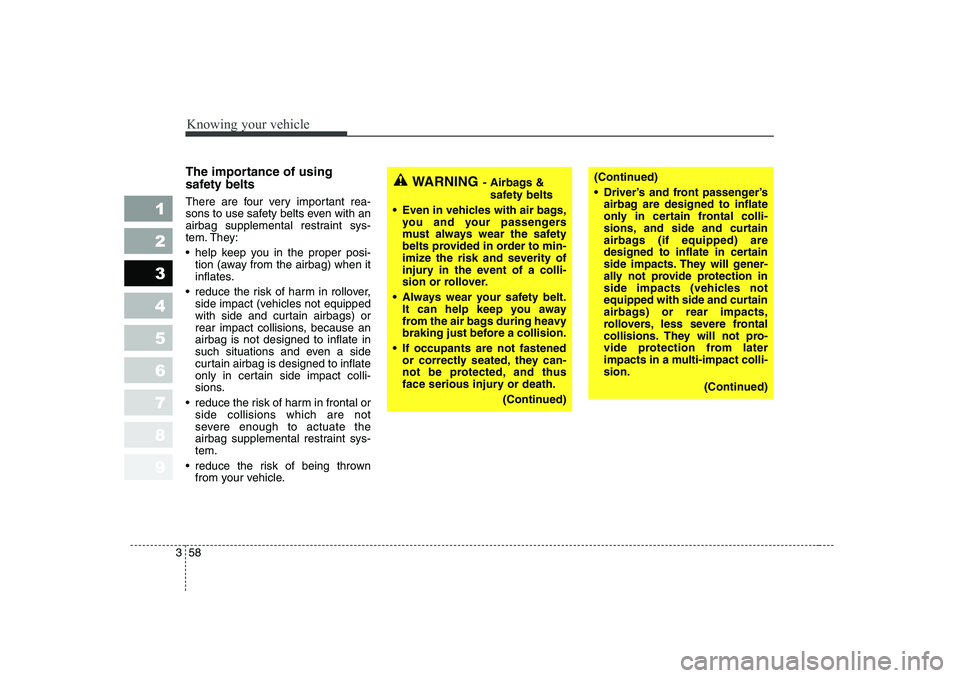
Knowing your vehicle
58
3
1 23456789
The importance of using
safety belts
There are four very important rea-
sons to use safety belts even with an
airbag supplemental restraint sys-
tem. They:
help keep you in the proper posi-
tion (away from the airbag) when it
inflates.
reduce the risk of harm in rollover, side impact (vehicles not equipped
with side and curtain airbags) or
rear impact collisions, because anairbag is not designed to inflate in
such situations and even a side
curtain airbag is designed to inflate
only in certain side impact colli-
sions.
reduce the risk of harm in frontal or side collisions which are not
severe enough to actuate the
airbag supplemental restraint sys-tem.
reduce the risk of being thrown from your vehicle.WARNING - Airbags &
safety belts
Even in vehicles with air bags, you and your passengers
must always wear the safety
belts provided in order to min-
imize the risk and severity of
injury in the event of a colli-
sion or rollover.
Always wear your safety belt. It can help keep you away
from the air bags during heavy
braking just before a collision.
If occupants are not fastened or correctly seated, they can-
not be protected, and thus
face serious injury or death.
(Continued)(Continued)
Driver’s and front passenger’sairbag are designed to inflate
only in certain frontal colli-
sions, and side and curtain
airbags (if equipped) are
designed to inflate in certain
side impacts. They will gener-
ally not provide protection in
side impacts (vehicles not
equipped with side and curtain
airbags) or rear impacts,
rollovers, less severe frontal
collisions. They will not pro-
vide protection from later
impacts in a multi-impact colli-sion.
(Continued)
Page 70 of 315
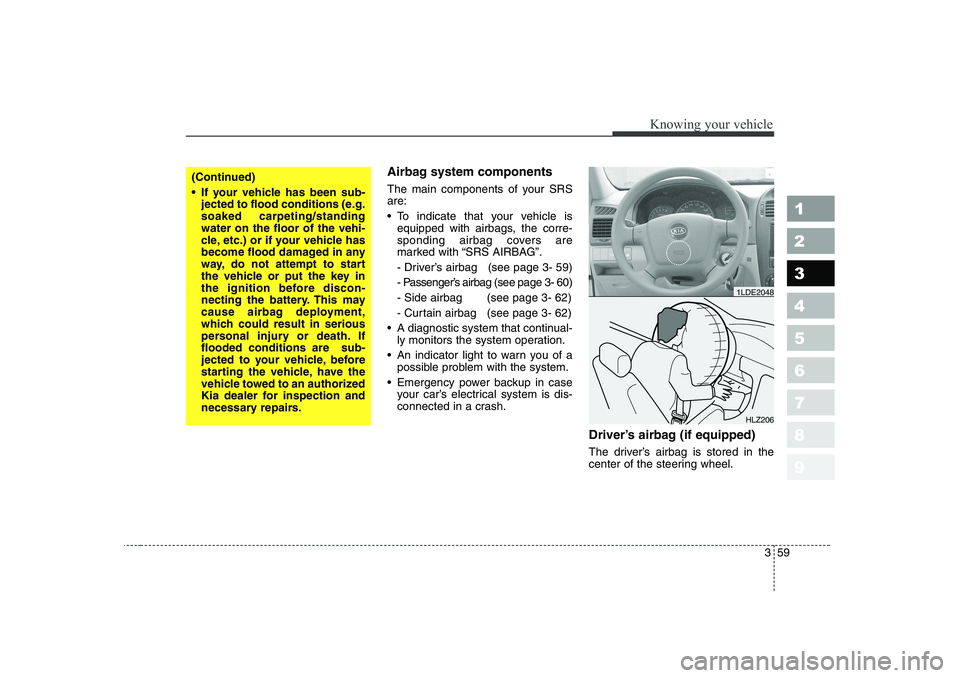
359
1 23456789
Knowing your vehicle
Airbag system components
The main components of your SRS are:
To indicate that your vehicle isequipped with airbags, the corre-
sponding airbag covers are
marked with “SRS AIRBAG”.
- Driver’s airbag (see page 3- 59)
- Passenger’s airbag (see page 3- 60)
- Side airbag (see page 3- 62)
- Curtain airbag (see page 3- 62)
A diagnostic system that continual- ly monitors the system operation.
An indicator light to warn you of a possible problem with the system.
Emergency power backup in case your car’s electrical system is dis-
connected in a crash.
Driver’s airbag (if equipped)
The driver’s airbag is stored in the
center of the steering wheel.
HLZ206
(Continued)
If your vehicle has been sub-jected to flood conditions (e.g. soaked carpeting/standingwater on the floor of the vehi-
cle, etc.) or if your vehicle has
become flood damaged in any
way, do not attempt to start
the vehicle or put the key in
the ignition before discon-
necting the battery. This may
cause airbag deployment,
which could result in serious
personal injury or death. Ifflooded conditions are sub-
jected to your vehicle, before
starting the vehicle, have the
vehicle towed to an authorized
Kia dealer for inspection and
necessary repairs.
1LDE2048